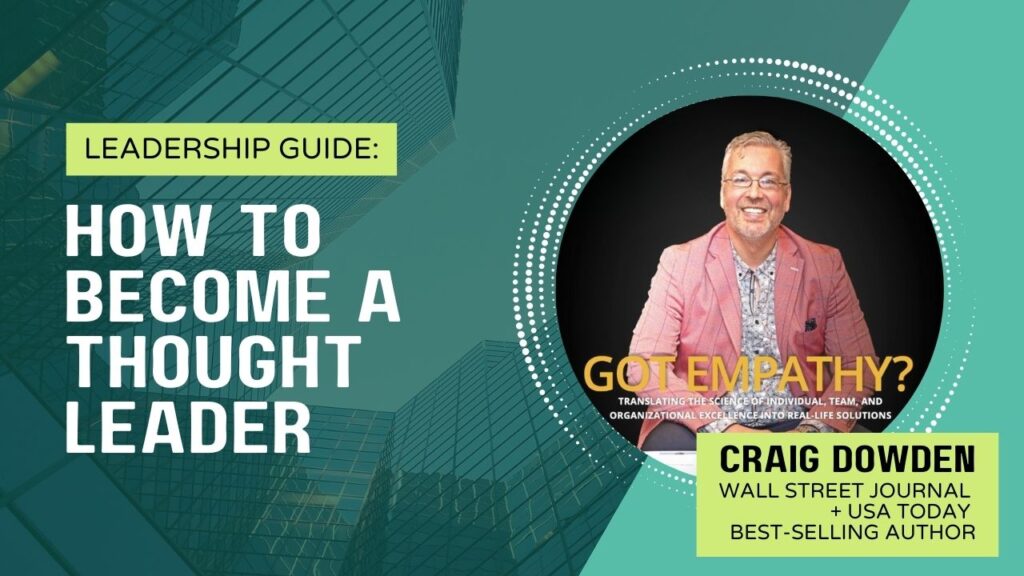Thought Leadership Guide: How to Become a Thought Leader as an Organization or Individual

Although the term “thought leader” is commonly used in marketing, PR, and consulting circles, “it’s for the market, the community, to decide on whether or not you’re a thought leader,” says Wall Street Journal and USA Today bestselling author Craig Dowden.
After all, the host of the Do Good To Lead Well podcast’s path to thought leadership was an organic one developed over years of accruing and sharing knowledge with readers and listeners.
At the same time, many PR and marketing groups at large organizations run thought leadership programs as a tactic to promote their brands.
So what exactly is thought leadership, and what does it take to cultivate it and establish authority in your industry? Read on for some expert tips.
What is Thought Leadership?
Gaining credibility as a thought leader is all about delivering value to audiences through education around a specific topic or subtopic in which you specialize. Thought leaders are valued because they don’t spend their time “selling” their audience – instead, their goal is to pique curiosity, foster discussion, and help readers and listeners learn something they can apply to their business.
At its core, Dowden says thought leadership is about “leading with value” by genuinely sharing expertise and experiences so others can benefit.
“When you’re contributing your thoughts, your ideas, and your research into the public forum, it’s a valuable way to demonstrate credibility while giving people an opportunity to get to know you a little more,” says Dowden, who collaborated with former Boeing CEO Alan Mullaly on his second book, A Time to Lead.
And if someone becomes a client or close contact because they view you or your company as an expert in your field, it’s all gravy.
Aaron Enneking, Director of Content at alternative investments firm Alto Solutions, says thought leadership is crucial for his company’s marketing and PR strategy. That’s partly because many prospects simply don’t know enough about alternative assets and self-directed Individual Retirement Arrangements (IRAs).
“Education is a key pillar of our mission,” Enneking explains, “and that’s where thought leadership comes in.”
Thought Leadership Tips: As an Organization
Enneking and his team are in the midst of rolling out a broad educational initiative, with various tracks of specific information, to the marketplace. That means creating, publishing, and disseminating lots of high-quality and informative content, he explains, with a goal of building and maintaining trust with his audience.
“The content has search value,” he explains, “but even more important is the trust value. And it has to stand out, which often means taking advantage of various mediums all at once through written pieces, audio, and video.”
Some of the content assets Alto Solutions employs to build influence in its field include:
- Frequent blog posts about investing, IRAs, other retirement accounts, and alternative investments
- Regular email newsletters with recent industry news
- Research projects to develop original content around industry issues
- Working with a PR agency to place the original research and data in news and feature stories, along with contributed and bylined op-eds
Enneking says the company’s most recent research project on investor sentiment generated significant web traffic, along with publicity for Alto in 30-plus media outlets, such as CNBC.
But one of the most valuable assets to come from the investor sentiment research wasn’t publicity – it was the insights gleaned from the research, including that most millennials believe they’ll be able to retire by age 59. “We found that surprising,” he says. “And it’s about finding those angles that are compelling and get people thinking.”
And catch a reporter’s eye, as well.
Most thought leadership experts say cultivating this kind of authority in your industry takes time, patience, and adherence to thought leadership best practices. Jessica Wong, Founder and CEO of PR marketing and PR firm Valux Digital, says in Forbes that adding value, being authentic, and staying consistent are the three most important elements of an aspiring thought leadership program.
“Being authentic makes a thought leader relatable,” she writes, adding that hiring ghostwriters for executives and others is a sound strategy – as long as they write in an authentic voice. “Readers, viewers and other users are more likely to become true followers when they feel they are meeting the real person online.”
Other tips for a successful thought leadership program that highlights your area of expertise can include:
- Contributing guest posts or writing guest media articles
- Publishing more long-form content
- Setting up a podcast
- Speaking at conferences and events
- Being interactive and answering questions on social media
- Keeping current on new industry trends
Thought Leadership Tips: As an Individual
It’s of course not just brands and organizations that can claim ownership to the thought leadership space. “Some of the most high-profile thought leaders have become brands of their own over time,” says Wong.
She says thought leadership strategies for individuals require a combination of the authenticity we mentioned earlier with a degree of personal branding and media savviness.
“A few decades ago, it might have been OK to appear a little stiff in front of the camera,” she explains. “Today, the same appearance would likely alienate audiences.”
PR professional Katerina Antonova says there are other ways individuals can build thought leadership credibility, such as:
- Becoming a mentor to professionals in your industry
- Managing your online reputation and presence
- Participating in digital communities and contributing guest posts
- Participating in expert roundup-style articles
Becoming an industry expert, as well, certainly helps. For his part, Dowden says he didn’t wake up with an epiphany that he had to become a thought leader or develop a strategy around that. “It was just a passion for adding to the conversation and delivering value to people – that was my motivational fuel,” he says.
Dowden got his start by writing business-style leadership articles in Ottawa Business Journal, a regional business publication. “I was passionate about wanting to contribute,” he explains. “And it was an invaluable experience in terms of learning how to frame my thoughts, and collaborate with a respected organization.”
He was then able to leverage those bylines to attract interest from other publications and organizations, developing a virtuous cycle that saw more articles published and more interest from other parties.
“Once you make some progress, you can assess where you’re at and what it means, and how you can potentially expand your reach. I wanted to keep contributing to the conversation and keep going up the ladder, if you will, to work with larger platforms and expand that conversation.”
The Potential Perils of Thought Leadership
No discussion around thought leadership is complete without a mention of its potential pitfalls – especially for individuals and organizations who force things or (even worse) trumpet themselves as a thought leader to their network.
In a sense, thought leadership is one of those things nearly everyone wants but that almost no one wants to say out loud – at least in terms of self-declaration.
“In some circles, you could argue that thought leadership can have a negative connotation,” says Dowden.
“It’s like, ‘Oh, here comes a thought leader,’” he adds with a laugh.
Enneking agrees, adding that thought leadership can grow organically if an individual or business follows the approach outlined above – and could shrivel if an individual or organization is too overt about their approach. “I think the best thought leaders never say they’re a thought leader,” says Enneking.
Ultimately, however, he says putting in the time and effort to build a credible program is worth it. “It all takes a lot of thought, but in the end it’s worth it for not just the awareness, but because customers and potential business partners could see the content. And that’s a huge credibility builder: To see a company is doing research and getting press.”
Measure Your Thought Leadership Program With Fullintel
Large organizations and Fortune 1000 companies use Fullintel’s award-winning human curation, predictive AI tools, and intuitive traditional and social media measurement dashboards to track the progress of their thought leadership programs. Contact us today to learn more.




